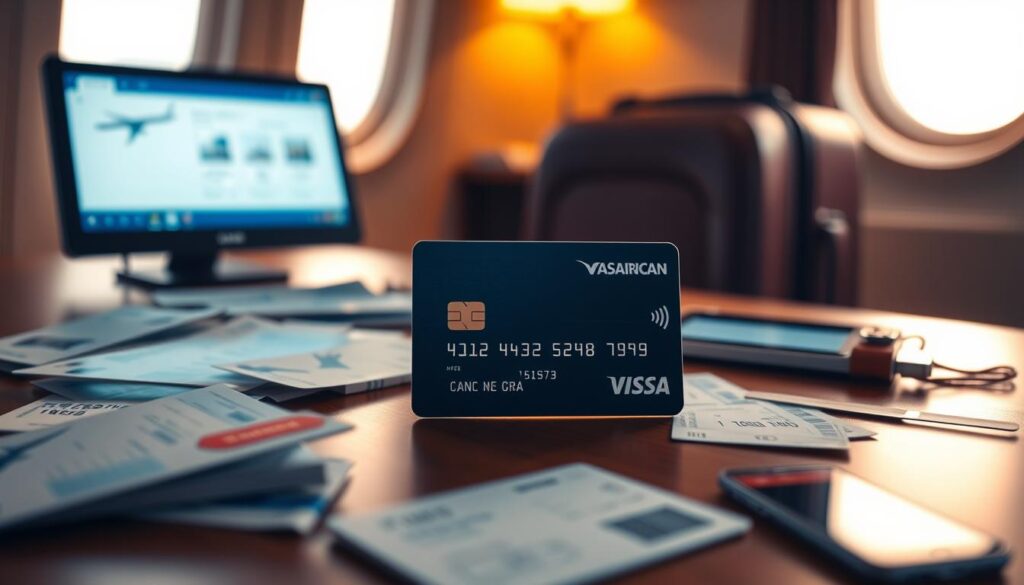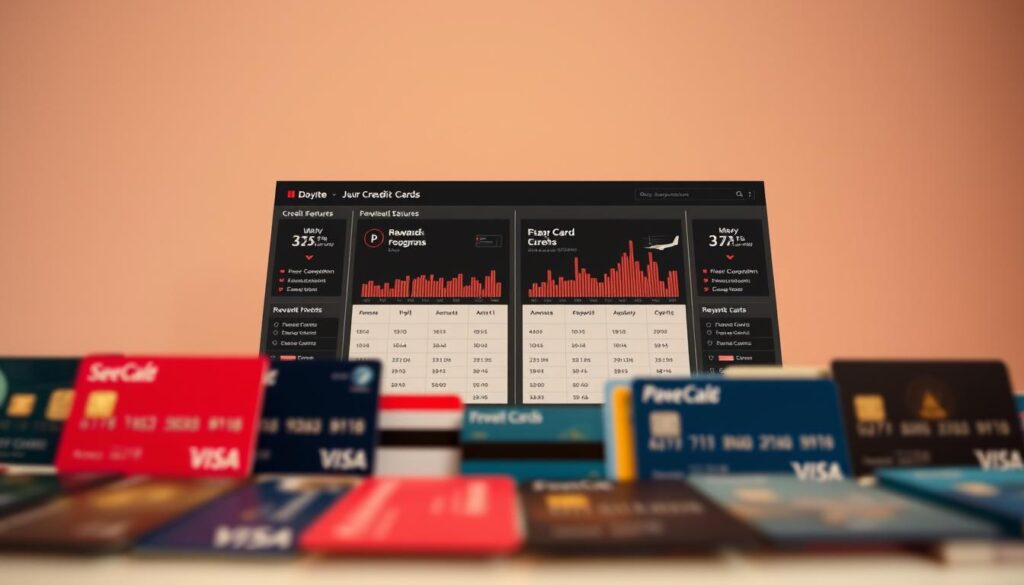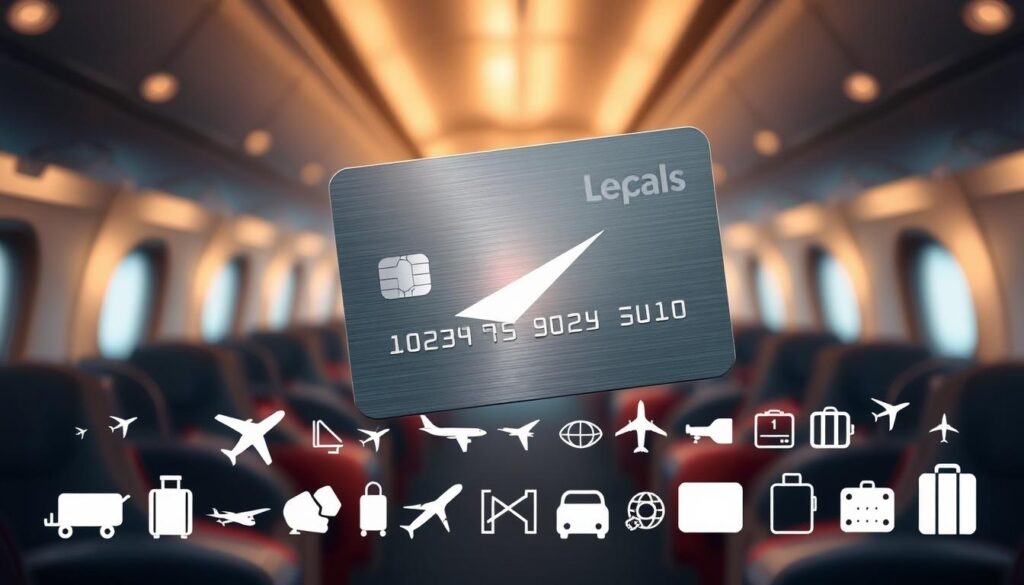How Do Credit Card Miles Work? in 2025
Ever wondered why so many travelers rave about their reward credit card perks? It’s simple: these programs turn everyday spending into exciting travel opportunities. With every purchase, you earn airline miles that can be redeemed for flights, hotels, or even cash back. It’s like having a secret travel fund that grows with your daily expenses.
Popular cards like the Capital One Venture or Chase Sapphire Preferred® offer sign-up bonuses and multipliers on specific spending categories. These features help you accumulate points faster, making your next vacation more affordable. Understanding the mechanics of earning and redeeming miles is key to maximizing their value.
Whether you’re booking a flight, upgrading your seat, or enjoying a luxury hotel stay, these rewards can significantly reduce your travel costs. The flexibility of redemption options ensures you get the most out of your loyalty program. Ready to explore how these programs can enhance your travel lifestyle? Let’s dive in!
Key Takeaways
- Earn airline miles with every purchase on a reward credit card.
- Sign-up bonuses and spending multipliers accelerate point accumulation.
- Redeem miles for flights, hotels, or statement credits.
- Popular cards like Capital One Venture offer competitive rewards.
- Understanding redemption options maximizes the value of your miles.
Understanding Credit Card Miles
Travel enthusiasts often turn to reward programs to unlock incredible benefits. These programs allow you to earn points, known as miles, which can be redeemed for flights, hotel stays, and other travel perks. The key to maximizing these rewards lies in understanding how they function and which type of card suits your needs.
What Are Credit Card Miles?
Credit card miles are points earned through purchases made with a reward credit card. These points can be redeemed for various travel-related expenses, such as flights, hotel bookings, or even cash back. The more you spend, the more miles you accumulate, making it a valuable tool for frequent travelers.
The Basics of Airline and Reward Miles
There are two main types of miles: airline miles and general reward miles. Airline miles are tied to specific carriers and are best for those loyal to a particular airline. General reward miles, on the other hand, offer flexibility and can be used across multiple travel platforms.
Different cards cater to different travel needs. For example, airline-specific cards often come with perks like free checked bags or priority boarding. General travel cards, like the Chase Sapphire Preferred®, provide points that can be transferred to various loyalty programs, offering greater versatility.
| Card Type | Best For | Key Perks |
|---|---|---|
| Airline Cards | Frequent flyers loyal to one airline | Free checked bags, priority boarding |
| Hotel Cards | Travelers who prefer hotel stays | Free nights, room upgrades |
| General Travel Cards | Flexible travelers | Transferable points, multiple redemption options |
Understanding the reward structure of your card is crucial. Look for features like sign-up bonuses, multipliers on specific spending categories, and redemption options. These factors can significantly enhance the value of your miles and make your travel dreams a reality.
How Do Credit Card Miles Work
Your daily purchases can turn into valuable travel perks with the right strategy. Every time you use your travel credit card, you earn points that can be redeemed for flights, hotels, or other rewards. These points, often called miles, accumulate based on your spending habits.
Earning Miles on Every Purchase
Every dollar you spend contributes to your reward program. Whether it’s groceries, gas, or dining out, your purchases add up. Many cards offer bonus points for specific categories, like travel or dining, allowing you to earn even faster.
For example, the Capital One Venture card offers 2X miles per dollar on all purchases. This means you’re doubling your rewards with every swipe. Tracking your spending helps you maximize these opportunities.
Reward Structures and Earning Rates
Different cards come with unique reward structures. Some offer flat rates on all purchases, while others provide higher rates for specific categories. Understanding these structures ensures you choose the best card for your lifestyle.
Here’s a comparison of popular cards:
| Card | Earning Rate | Bonus Categories |
|---|---|---|
| Capital One Venture | 2X miles per dollar | All purchases |
| Chase Sapphire Preferred® | 2X points on travel and dining | Travel, dining |
| American Express Gold | 4X points on dining and groceries | Dining, groceries |
Maximizing your rewards involves using the right card for each purchase. Pay attention to bonus categories and sign-up offers to accelerate your point accumulation. With the right strategy, your next trip could be closer than you think.
Earning Airline Miles Through Credit Cards
Turning everyday expenses into travel opportunities is easier than you think. By using the right financial tools, you can accumulate airline miles that bring your dream destinations closer. Co-branded cards and general travel rewards cards are two effective ways to earn these points.

How to Get Airline Miles Explained
Co-branded cards, like those from Delta or American Airlines, are tied to specific carriers. These cards often come with perks such as free checked bags or priority boarding. They’re ideal for frequent flyers loyal to one airline.
General travel cards, such as the Chase Sapphire Preferred®, offer flexibility. You can transfer points to multiple loyalty programs, making them versatile for various travel needs. Both types of cards reward you for everyday spending, turning purchases into miles.
Sign-Up Bonuses and Early-Spend Offers
Many cards offer attractive sign-up bonuses to kickstart your mileage accumulation. For example, the Capital One Venture card provides a bonus after meeting a specific spending threshold within the first few months. These offers can add significant value to your account.
Early-spend promotions are another way to boost your points. By meeting the required spending amount, you can earn extra miles quickly. This strategy is especially useful for planning upcoming trips.
Comparing card offers ensures you find the best match for your travel goals. Look for features like bonus categories, transferable points, and low annual fees. With the right card, your next adventure could be just a swipe away.
Maximizing Your Reward Miles
Unlocking the full potential of your accumulated points can transform your travel experience. With the right strategies, you can turn those hard-earned rewards into unforgettable trips. Let’s explore how to make the most of your mile credit card benefits.

Redemption Options for Travel and More
Your travel credit card offers a variety of ways to use your points. From booking flights to securing hotel stays, the options are endless. Here are some popular choices:
- Flights: Use your points to cover airfare, saving you hundreds on your next trip.
- Hotels: Redeem for stays at luxury resorts or budget-friendly accommodations.
- Car Rentals: Apply your rewards to transportation costs during your travels.
- Statement Credits: Convert points into cash back to offset your expenses.
Understanding your issuer’s redemption policies is crucial. Some programs offer better value for specific options, so always compare before redeeming.
Leveraging Special Perks and Bonuses
Many card issuers provide exclusive perks to enhance your experience. These can include:
- Travel Insurance: Protect your trips with coverage for delays, cancellations, or lost luggage.
- Airport Lounge Access: Enjoy complimentary access to lounges for a more comfortable travel experience.
- Bonus Points: Take advantage of limited-time offers to earn extra points on specific purchases.
Timing your redemptions can also maximize value. For example, booking during off-peak seasons often requires fewer points. Additionally, using comparison tools ensures you’re getting the best deal.
“The key to maximizing rewards is staying informed and planning ahead.”
By understanding your options and leveraging these perks, you can make every point count. Start exploring your redemption choices today and turn your dreams into reality.
The Relationship Between Spending and Mileage Accrual
Your spending habits play a crucial role in how quickly you accumulate travel rewards. Every purchase you make can contribute to your mile balance, but the rate at which you earn depends on the type of credit card you use and the categories you spend in.

Many travel credit cards offer multipliers on specific categories, such as dining, groceries, or online shopping. These multipliers can significantly boost your reward earnings, turning everyday expenses into valuable points.
Multipliers on Daily Purchases
Multipliers are a game-changer for maximizing your mile accumulation. For example, some cards offer 2X or even 4X points on categories like travel or dining. This means you earn more for every dollar spent in these areas.
Here’s a comparison of popular cards and their earning rates:
| Card | Earning Rate | Bonus Categories |
|---|---|---|
| Capital One Venture | 2X miles per dollar | All purchases |
| Chase Sapphire Preferred® | 2X points on travel and dining | Travel, dining |
| American Express Gold | 4X points on dining and groceries | Dining, groceries |
Strategizing Your Spending
To make the most of your credit card rewards, focus on using the right card for each purchase. For instance, use a card with high multipliers for dining when eating out or one with travel bonuses for booking flights.
Tracking your spending habits helps you identify opportunities to earn more. By aligning your purchases with bonus categories, you can accelerate your reward accumulation and reach your travel goals faster.
Impact of Fees and Categories
While multipliers can boost your earnings, it’s essential to consider fees and spending categories. Some cards charge annual fees, but the benefits often outweigh the costs if you maximize your rewards. Additionally, focusing on high-multiplier categories ensures you get the best value for your spending.
By understanding how your spending affects your mile balance, you can make informed decisions and optimize your rewards strategy. Start leveraging multipliers today and watch your travel fund grow!
Comparing Travel Credit Cards and Rewards Programs
Choosing the right travel rewards program can make all the difference in your journey. With so many options available, understanding the benefits of co-branded airline cards versus general travel cards is essential. Each type offers unique perks, and your decision should align with your spending habits and travel goals.

Airline Credit Cards vs. General Travel Cards
Co-branded airline cards are tied to specific carriers, offering perks like free checked bags, priority boarding, and exclusive discounts. These cards are ideal for frequent flyers loyal to one airline. For example, the Delta SkyMiles® Card provides benefits tailored to Delta travelers.
General travel cards, like the Chase Sapphire Preferred®, offer more flexibility. Points can be transferred to multiple loyalty programs, making them versatile for various travel needs. These cards often come with higher earning rates on categories like dining and travel.
Loyalty Programs and Transferability
Loyalty programs play a significant role in maximizing your rewards. Co-branded cards often limit redemptions to their specific airline, while general travel cards allow transfers to multiple partners. For instance, American Express Membership Rewards can be transferred to over 20 airline and hotel partners.
Transferability adds value by letting you choose the best redemption options. This flexibility ensures you get the most out of your points, whether booking a flight or upgrading your hotel stay.
Here’s a comparison of popular cards:
| Card | Type | Key Benefits |
|---|---|---|
| Delta SkyMiles® Card | Airline | Free checked bags, priority boarding |
| Chase Sapphire Preferred® | General Travel | Transferable points, 2X on travel and dining |
| American Express Gold | General Travel | 4X on dining and groceries, transfer partners |
When selecting a card, consider your spending habits and travel preferences. A co-branded card may suit frequent flyers, while a general travel card offers broader options. By comparing features like bonus rates, redemption flexibility, and fees, you can find the perfect fit for your lifestyle.
Utilizing Credit Card Miles for Flight and Travel Upgrades
Your accumulated points can open doors to premium travel experiences. Whether you’re planning a vacation or a business trip, your credit card mile balance can be a game-changer. From booking flights to securing upgrades, these rewards enhance your journey without straining your budget.

Booking Flights with Your Miles
One of the most popular ways to use your airline mile balance is to book flights. Instead of paying with cash, you can redeem your points for airfare. Many travel credit card programs allow you to book directly through their portals or transfer points to partner airlines.
For example, the Chase Sapphire Preferred® lets you transfer points to airlines like United or Southwest. This flexibility ensures you get the best value for your rewards. Always compare redemption rates to maximize your mile usage.
Securing Upgrades and Additional Perks
Beyond flights, your points can elevate your travel experience. Use them to upgrade to business or first class, turning a standard trip into a luxurious one. Many card issuers offer this option, often at a fraction of the cash cost.
Additional perks include access to airport lounges, extra baggage allowances, and priority boarding. For instance, the American Express Platinum card provides complimentary lounge access, making layovers more comfortable.
Here are some examples of major airlines and their upgrade benefits:
- Delta SkyMiles®: Use miles for seat upgrades and priority boarding.
- United MileagePlus®: Redeem points for premium cabin upgrades.
- American Airlines AAdvantage®: Access exclusive perks like lounge passes.
Review your card’s redemption options to ensure you’re making the most of your rewards. With the right strategy, your next trip could be more comfortable and cost-effective than ever.
Navigating Sign-Up Bonuses and Promotional Offers
Sign-up bonuses and promotional offers can be a game-changer for your travel rewards strategy. These incentives are designed to attract new users and reward them for meeting specific spending requirements. Understanding how to evaluate these offers ensures you maximize their value.
What Are Sign-Up Bonuses?
Sign-up bonuses are rewards offered by credit card issuers to new cardholders. Typically, you’ll earn a large number of points or airline miles after spending a certain amount within the first few months. These bonuses can significantly boost your mile balance, making them a valuable tool for travelers.
Evaluating Offer Terms and Conditions
When reviewing promotional offers, pay attention to the fine print. Key factors to consider include:
- Spending Thresholds: The amount you need to spend to qualify for the bonus.
- Time Frame: The period within which you must meet the spending requirement.
- Fees: Annual fees or other charges that may offset the bonus value.
For example, the Capital One Venture card offers a bonus of 75,000 miles after spending $4,000 in the first three months. This type of offer can be highly rewarding if you plan your spending accordingly.
Examples of Attractive Bonus Offers
Here are some popular cards and their sign-up bonuses:
| Card | Bonus | Spending Requirement |
|---|---|---|
| Chase Sapphire Preferred® | 60,000 points | $4,000 in 3 months |
| American Express Gold | 60,000 points | $4,000 in 6 months |
| Delta SkyMiles® Card | 50,000 miles | $2,000 in 3 months |
Impact of Fees and Terms
While sign-up bonuses are enticing, it’s essential to consider the card’s fee structure. Some cards charge annual fees, but the benefits often outweigh the costs if you maximize your rewards. Additionally, ensure the spending requirement aligns with your budget to avoid unnecessary debt.
Best Practices for Comparing Offers
To secure the best deal, compare multiple offers based on:
- Bonus Value: The number of points or miles offered.
- Redemption Flexibility: Options for using your rewards.
- Long-Term Benefits: Ongoing perks like multipliers or travel credits.
By carefully evaluating these factors, you can choose the offer that best suits your travel goals and spending habits.
Tips for Managing and Redeeming Your Miles
Maximizing the value of your rewards requires careful planning and smart strategies. Whether you’re saving for a dream vacation or looking to upgrade your next trip, these tips will help you make the most of your credit card mile balance.
Track Your Miles and Monitor Expiration Dates
Keeping track of your earned miles is essential. Many reward programs have expiration policies, so regularly check your account to ensure your points don’t go to waste. Use tools like airline apps or credit card portals to monitor your balance.
Set reminders for expiration dates and plan redemptions accordingly. This proactive approach ensures you never lose hard-earned rewards.
Strategize Redemptions for Maximum Value
Timing is key when redeeming your miles. Look for special offers or off-peak periods when fewer points are required for flights or hotel stays. Transferring points to partner programs can also increase their value.
For example, redeeming during promotions can save you thousands of points. Always compare redemption rates across platforms to ensure you’re getting the best deal.
Avoid Common Mistakes
One common mistake is hoarding points for too long. Expiration policies or devaluations can reduce their worth. Another pitfall is not understanding your program’s rules, such as blackout dates or restrictions.
Review your card’s terms and conditions to avoid surprises. This knowledge helps you make informed decisions and maximize your rewards.
Use Tools and Apps to Optimize Mile Usage
Several tools can help you manage and redeem your miles effectively. Apps like AwardWallet or TripIt track your balances across multiple programs. These tools also alert you to expiration dates and special offers.
Here’s a comparison of popular tools:
| Tool | Features | Best For |
|---|---|---|
| AwardWallet | Balance tracking, expiration alerts | Multi-program users |
| TripIt | Itinerary management, reward tracking | Frequent travelers |
| MileagePlus X | Bonus miles on purchases | United Airlines users |
Regularly Review Your Rewards Program
Programs often update their benefits or add new partners. Stay informed about changes to maximize your mile usage. Adjust your spending habits to align with bonus categories or promotions.
By staying proactive, you can ensure your rewards continue to grow and provide the most value for your travel needs.
Conclusion
Taking control of your travel rewards can transform your journey into an unforgettable experience. By understanding how to earn and redeem points, you unlock a world of possibilities. From booking flights to enjoying exclusive perks, these programs offer incredible value for every purchase.
To maximize your rewards, focus on strategies like leveraging bonus categories and comparing offers. Always review terms and conditions to ensure you’re getting the best deal. Whether you’re loyal to a specific airline or prefer flexible programs, there’s a solution tailored to your needs.
Start applying these insights today and take charge of your travel plans. With the right approach, your next adventure could be closer than you think.
FAQ
What are credit card miles?
Credit card miles are rewards earned through spending on a travel or airline credit card. You can redeem them for flights, upgrades, hotel stays, or other travel-related expenses.
How do you earn miles on purchases?
You earn miles by using your card for everyday spending. Many cards offer bonus miles in specific categories like dining, groceries, or travel, along with a base rate on all purchases.
What’s the difference between airline miles and general travel miles?
Airline miles are tied to a specific airline’s loyalty program, while general travel miles can be used across multiple airlines, hotels, or other travel services, offering more flexibility.
How do sign-up bonuses work?
Sign-up bonuses reward you with a large number of miles after meeting a minimum spending requirement within a set time frame, often within the first few months of opening your account.
What are the best ways to redeem miles?
You can redeem miles for flights, hotel stays, car rentals, or even cash back. For maximum value, consider using them for travel bookings or upgrades.
Can you transfer miles between loyalty programs?
Some credit card programs allow you to transfer miles to partner airline or hotel loyalty programs, giving you more options for redemption.
How do spending multipliers boost mileage accrual?
Spending multipliers increase the number of miles you earn in specific categories, such as 2x or 3x miles on travel, dining, or gas purchases.
What are the perks of travel credit cards?
Travel credit cards often include perks like airport lounge access, travel insurance, no foreign transaction fees, and exclusive discounts on bookings.
How can you maximize the value of your miles?
To maximize value, redeem miles for high-cost travel expenses, take advantage of transfer partners, and use them during promotional redemption periods.
What should you look for in a sign-up bonus offer?
Check the minimum spending requirement, the time frame to meet it, and the bonus value compared to the card’s annual fee to ensure it’s worth it for your spending habits.
